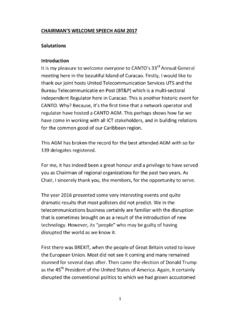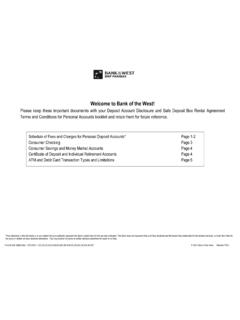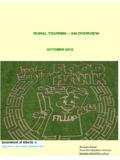Transcription of Welcome to the Purdue OWL - California State University ...
1 Welcome to the Purdue OWLThis page is brought to you by the OWL at Purdue ( ). When printing this page, you must include the entire legal notice at :Elizabeth Angeli, Jodi Wagner, Elena Lawrick, Kristen Moore, Michael Anderson, Lars Soderlund, Allen Brizee. Summary: APA (American Psychological Association) is most commonly used to cite sources within the social sciences. This resource, revised according to the 6th edition of the APA manual, offers examples for the general format of APA research papers, in-text citations, endnotes/footnotes, and the reference page. For more information, please consult the Publication Manual of the American Psychological Association, 6th edition, second FormatPlease use the example at the bottom of this page to cite the Purdue OWL in APA GuidelinesYour essay should be typed, double-spaced on standard-sized paper ( " x 11") with 1" margins on all sides.
2 You should use 10-12 pt. Times New Roman font or a similar a page header at the top of every page. To create a page header, insert page numbers flush right. Then type "TITLE OF YOUR PAPER" in the header flush Paper SectionsYour essay should include four major sections: the Title Page, Abstract, Main Body, and PageThe title page should contain the title of the paper, the author's name, and the institutional affiliation. Include the page header (described above) flush left with the page number flush right at the top of the page. Please note that on the title page, your page header should look like this:Running head: TITLE OF YOUR PAPERPage 1 of 56 Purdue OWL Engagement8/19/2010 after the title page should have a running head that looks like this:TITLE OF YOUR PAPERA fter consulting with publication specialists at the APA, OWL staff learned that the APA 6th edition sample papers have incorrect examples of Running heads on pages after the title page.
3 This link will take to you the APA site where you can find a complete list of all the errors in the APA's 6th edition style your title in upper and lowercase letters centered in the upper half of the page. APA recommends that your title be no more than 12 words in length and that it should not contain abbreviations or words that serve no purpose. Your title may take up one or two lines. All text on the title page, and throughout your paper, should be the title, type the author's name: first name, middle initial(s), and last name. Do not use titles (Dr.) or degrees ( ).Beneath the author's name, type the institutional affiliation, which should indicate the location where the author(s) conducted the 2 of 56 Purdue OWL Engagement8/19/2010 Image Caption: APA Title PageAbstractBegin a new page.
4 Your abstract page should already include the page header (described above). On the first line of the abstract page, center the word Abstract (no bold, formatting, italics, underlining, or quotation marks).Beginning with the next line, write a concise summary of the key points of your research. (Do not indent.) Your abstract should contain at least your research topic, research questions, participants, methods, results, data analysis, and conclusions. You may also include possible implications of your research and future work you see connected with your findings. Your abstract should be a single paragraph double-spaced.
5 Your abstract should be between 150 and 250 may also want to list keywords from your paper in your abstract. To do this, center the text and type Keywords: (italicized) and then list your keywords. Listing your keywords will help researchers find your work in 3 of 56 Purdue OWL Engagement8/19/2010 Image Caption: APA Abstract PagePlease see our Sample APA Paper resource to see an example of an APA paper. You may also visit our Additional Resources page for more examples of APA to Cite the Purdue OWL in APAI ndividual ResourcesContributors' names and the last edited date can be found in the orange boxes at the top of every page on the ' names (Last edited date).
6 Title of resource. Retrieved from http://Web address for OWL resource Page 4 of 56 Purdue OWL Engagement8/19/2010 , E., Wagner, J., Lawrick, E., Moore, K., Anderson, M., Soderland, L., & Brizee, A. (2010, May 5). General format. Retrieved from Contributors:Elizabeth Angeli, Jodi Wagner, Elena Lawrick, Kristen Moore, Michael Anderson, Lars Soderlund, Allen Brizee. Summary: APA (American Psychological Association) is most commonly used to cite sources within the social sciences. This resource, revised according to the 6th edition of the APA manual, offers examples for the general format of APA research papers, in-text citations, endnotes/footnotes, and the reference page.
7 For more information, please consult the Publication Manual of the American Psychological Association, 6th edition, second Citations: The BasicsReference citations in text are covered on pages 169-179 of the Publication Manual. What follows are some general guidelines for referring to the works of others in your : APA style requires authors to use the past tense or present perfect tense when using signal phrases to describe earlier research. , Jones (1998) found or Jones (1998) has Citation BasicsWhen using APA format, follow the author-date method of in-text citation. This means that the author's last name and the year of publication for the source should appear in the text, , (Jones, 1998), and a complete reference should appear in the reference list at the end of the you are referring to an idea from another work but NOT directly quoting the material, or making reference to an entire book, article or other work, you only have to make reference to the author and year of publication in your in-text Citation Capitalization, Quotes, and Italics/UnderliningAlways capitalize proper nouns, including author names and initials: D.
8 Jones. If you refer to the title of a source within your paper, capitalize all words that are four letters long or greater within the title of a source: Permanence and Change. Exceptions apply to short words that are verbs, nouns, pronouns, adjectives, and adverbs: Writing New Media, There Is Nothing Left to Lose. Page 5 of 56 Purdue OWL Engagement8/19/2010 (Note: in your References list, only the first word of a title will be capitalized: Writing new media.)When capitalizing titles, capitalize both words in a hyphenated compound word: Natural-Born Cyborgs. Capitalize the first word after a dash or colon: "Defining Film Rhetoric: The Case of Hitchcock's Vertigo.
9 " Italicize or underline the titles of longer works such as books, edited collections, movies, television series, documentaries, or albums: The Closing of the American Mind; The Wizard of Oz; Friends. Put quotation marks around the titles of shorter works such as journal articles, articles from edited collections, television series episodes, and song titles: "Multimedia Narration: Constructing Possible Worlds"; "The One Where Chandler Can't Cry." Short QuotationsIf you are directly quoting from a work, you will need to include the author, year of publication, and the page number for the reference (preceded by "p.)
10 "). Introduce the quotation with a signal phrase that includes the author's last name followed by the date of publication in to Jones (1998), "Students often had difficulty using APA style, especially when it was their first time" (p. 199). Jones (1998) found "students often had difficulty using APA style" (p. 199); what implications does this have for teachers?If the author is not named in a signal phrase, place the author's last name, the year of publication, and the page number in parentheses after the stated, "Students often had difficulty using APA style" (Jones, 1998, p. 199), but she did not offer an explanation as to QuotationsPlace direct quotations longer than 40 words in a free-standing block of typewritten lines, and omit quotation marks.

















